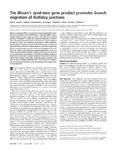The Bloom's syndrome gene product promotes branch migration of holliday junctions.
| dc.contributor.author | Karow, JK | en |
| dc.contributor.author | Constantinou, A | en |
| dc.contributor.author | Li, JL | en |
| dc.contributor.author | West, SC | en |
| dc.contributor.author | Hickson, ID | en |
| dc.date.accessioned | 2017-11-27T18:44:26Z | |
| dc.date.available | 2017-11-27T18:44:26Z | |
| dc.date.issued | 2000-06-06 | en |
| dc.identifier.issn | 0027-8424 | en |
| dc.identifier.uri | http://hdl.handle.net/10026.1/10325 | |
| dc.description.abstract |
Bloom's syndrome (BS) is an autosomal recessive disorder associated with dwarfism, immunodeficiency, reduced fertility, and elevated levels of many types of cancer. BS cells show marked genomic instability; in particular, hyperrecombination between sister chromatids and homologous chromosomes. This instability is thought to result from defective processing of DNA replication intermediates. The gene mutated in BS, BLM, encodes a member of the RecQ family of DExH box DNA helicases, which also includes the Werner's syndrome gene product. We have investigated the mechanism by which BLM suppresses hyperrecombination. Here, we show that BLM selectively binds Holliday junctions in vitro and acts on recombination intermediates containing a Holliday junction to promote ATP-dependent branch migration. We present a model in which BLM disrupts potentially recombinogenic molecules that arise at sites of stalled replication forks. Our results have implications for the role of BLM as an anti-recombinase in the suppression of tumorigenesis. | en |
| dc.format.extent | 6504 - 6508 | en |
| dc.language | eng | en |
| dc.language.iso | eng | en |
| dc.subject | Adenosine Triphosphatases | en |
| dc.subject | Bloom Syndrome | en |
| dc.subject | DNA Helicases | en |
| dc.subject | Humans | en |
| dc.subject | RecQ Helicases | en |
| dc.subject | Recombination, Genetic | en |
| dc.title | The Bloom's syndrome gene product promotes branch migration of holliday junctions. | en |
| dc.type | Journal Article | |
| plymouth.author-url | https://www.ncbi.nlm.nih.gov/pubmed/10823897 | en |
| plymouth.issue | 12 | en |
| plymouth.volume | 97 | en |
| plymouth.publication-status | Published | en |
| plymouth.journal | Proc Natl Acad Sci U S A | en |
| dc.identifier.doi | 10.1073/pnas.100448097 | en |
| plymouth.organisational-group | /Plymouth | |
| plymouth.organisational-group | /Plymouth/REF 2021 Researchers by UoA | |
| plymouth.organisational-group | /Plymouth/REF 2021 Researchers by UoA/UoA01 Clinical Medicine | |
| plymouth.organisational-group | /Plymouth/REF 2021 Researchers by UoA/UoA01 Clinical Medicine/UoA01 Clinical Medicine | |
| dc.publisher.place | United States | en |
| dc.rights.embargoperiod | Not known | en |
| rioxxterms.versionofrecord | 10.1073/pnas.100448097 | en |
| rioxxterms.licenseref.uri | http://www.rioxx.net/licenses/all-rights-reserved | en |
| rioxxterms.type | Journal Article/Review | en |


